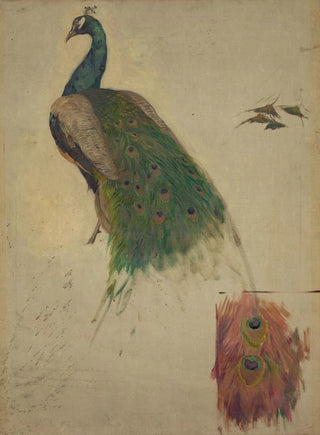Art print | Study of peacock science in the eardrum - Kenyon Cox


View from behind

Frame (optional)
Art print of the Study of peacock sciences in the tympanum by Kenyon Cox – Captivating introduction
In the rich and complex universe of art, some works stand out for their ability to capture the very essence of beauty and knowledge. "Study of peacock sciences in the tympanum" by Kenyon Cox is one of those creations that transcend the simple status of an art piece to become a true visual manifesto. Through this work, Cox invites us to explore the relationship between art and science, while celebrating the majesty of the peacock, a symbol of beauty and wisdom. This piece, both delicate and powerful, evokes a world where nature and intellect intertwine, offering a profound reflection on our quest for understanding.
Style and uniqueness of the work
Kenyon Cox's work is characterized by a style that harmoniously blends classicism with a modernist approach. "Study of peacock sciences in the tympanum" stands out with its flowing lines and vibrant colors, creating an atmosphere that is both serene and dynamic. The peacock, majestic in its posture, occupies a central place, drawing the eye and inspiring admiration. The meticulous details of its feathers, drawn with remarkable precision, testify to the artist's talent in capturing light and movement. Cox also uses symbolic motifs to enrich the composition, transforming the tympanum into a true narrative tableau. Every element, from colors to shapes, contributes to a visual harmony that invites contemplation and wonder.
The artist and his influence
Kenyon Cox, an emblematic figure of the late 19th and early 20th centuries, left his mark on his era with a unique approach to art. Influenced by the artistic movements of his time, he managed to incorporate elements of classical art while opening up to new ideas of his period. Cox was also a passionate advocate for artistic education, firmly believing in the importance of training for artists. His work, while rooted in an academic tradition, is nourished by his personal reflections on beauty and knowledge, giving it a depth and relevance that still resonate today. Through "Study of sciences

Matte finish

View from behind

Frame (optional)
Art print of the Study of peacock sciences in the tympanum by Kenyon Cox – Captivating introduction
In the rich and complex universe of art, some works stand out for their ability to capture the very essence of beauty and knowledge. "Study of peacock sciences in the tympanum" by Kenyon Cox is one of those creations that transcend the simple status of an art piece to become a true visual manifesto. Through this work, Cox invites us to explore the relationship between art and science, while celebrating the majesty of the peacock, a symbol of beauty and wisdom. This piece, both delicate and powerful, evokes a world where nature and intellect intertwine, offering a profound reflection on our quest for understanding.
Style and uniqueness of the work
Kenyon Cox's work is characterized by a style that harmoniously blends classicism with a modernist approach. "Study of peacock sciences in the tympanum" stands out with its flowing lines and vibrant colors, creating an atmosphere that is both serene and dynamic. The peacock, majestic in its posture, occupies a central place, drawing the eye and inspiring admiration. The meticulous details of its feathers, drawn with remarkable precision, testify to the artist's talent in capturing light and movement. Cox also uses symbolic motifs to enrich the composition, transforming the tympanum into a true narrative tableau. Every element, from colors to shapes, contributes to a visual harmony that invites contemplation and wonder.
The artist and his influence
Kenyon Cox, an emblematic figure of the late 19th and early 20th centuries, left his mark on his era with a unique approach to art. Influenced by the artistic movements of his time, he managed to incorporate elements of classical art while opening up to new ideas of his period. Cox was also a passionate advocate for artistic education, firmly believing in the importance of training for artists. His work, while rooted in an academic tradition, is nourished by his personal reflections on beauty and knowledge, giving it a depth and relevance that still resonate today. Through "Study of sciences






